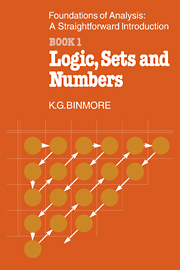10 - Construction of the number systems
Published online by Cambridge University Press: 07 January 2010
Summary
Models
A model for a list of axioms is an example of a system in which the axioms hold. It is the models in terms of which a list of axioms can be interpreted which make the axioms interesting.
But models can also be useful in examining the structure of systems of axioms. A famous example relates to Euclid's parallel postulate. Many mathematicians tried for a very long time to deduce this postulate from the other axioms of Euclidean geometry. All attempts were unsuccessful because the project is impossible. Models can be constructed in which all the other axioms of Euclidean geometry are true but the parallel postulate is false.
In this chapter, we construct a model for the real number axioms. The primary reason for producing this model is that its existence demonstrates that the axioms given for the real number system are consistent – i.e. they do not lead to a contradiction. It need hardly be said that an inconsistency in the axioms for the real number system would be a total disaster for the whole of analysis and most other branches of mathematics as well.
We have already seen (§9.21) that there is essentially only one model of the real number system – i.e. all models have precisely the same structure and differ only in the symbols which are used to label their elements. It therefore makes sense to identify a real number with the object we shall construct to represent it – i.e. to say that our model is the real number system.
- Type
- Chapter
- Information
- The Foundations of Analysis: A Straightforward IntroductionBook 1 Logic, Sets and Numbers, pp. 78 - 97Publisher: Cambridge University PressPrint publication year: 1981

